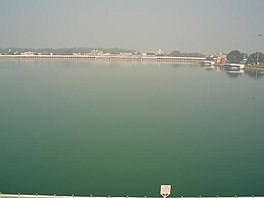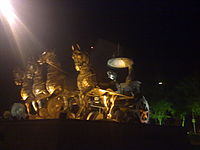Brahma Sarovar
| Brahma Sarovar | |
|---|---|
 | |
 Brahma Sarovar | |
| Location | , Haryana |
| Coordinates | 29°58′N 76°50′E / 29.96°N 76.83°E |
| Basin countries | |
| Max. length | 3,600 ft (1,100 m) |
| Max. width | 1,800 ft (550 m) |
| Max. depth | 45 ft (14 m) |
Brahma Sarovar is an ancient water pool sacred to Hinduism in , in the state of Haryana in North India,India.[1] Hinduism lays emphasis on taking bath for internal and external purity. Most religious sites have water pools or sarovar in or near the Hindu temple and Sikh gurdwara. The Hindu genealogy registers at Kurukshetra, Haryana are kept here.
History[]
According to stories of itihasa , Lord Brahma created the universe from the land of Kurukshetra after a huge yajna. The Brahma Sarovar here is believed to be the cradle of civilization. The sarovar is also mentioned in the eleventh century AD memoirs of Al Beruni, called 'Kitab-ul-Hind'. The sarovar also has a mention in Mahabharata citing its use by Duryodhana to hide himself underwater on the concluding day of the war.
A sacred shrine dedicated to Lord Shiva stands within the sarovar, accessible by a small bridge. According to scriptures, bathing in this sarovar increases the sanctity of performing the 'ashvamedh yajna'. The pool offers a breath-taking sight during the Gita Jayanti celebrations held each year in the last week of November and early December when a 'deep daan' ceremony of floating lamps in water and [Aarti] occurs.[2] This also happens to be the time when migratory birds from distant places arrive at the sarovar. The Birla Gita Mandir and Baba Nath's haveli and temple are the neighbouring attractions.

Brahma Sarovar Kurukshetra

Sri Krishna Chariot at Brahma Sarovar Kurukshetra
Solar eclipse ritual[]
The pools are especially crowded during solar eclipses because it is believed that bathing there during the solar eclipse is an ablution of sin. On 29 March 2006, a solar eclipse was visible in the region and it drew an estimated one million people to the site.[3] Whenever an eclipse is visible from the Sarovar, hundreds of thousands gather in the pools.[4]
Bibliography[]
- Jagmohan (2005). Soul and Structure of Governance in India. Mumbai: Allied Publishers.
- Kamran, Krishnam (1997). Tourism: Theory, Planning, and Practice. New Delhi: Indus Publishing.
- (2006). "Kurukshetra Calling." The Statesman (India). 5 September.
- Prasad, Ramanuj (2005). Know Your Puranas. Delhi: Pustak Mahal.
References[]
- ^ "Religious Places in Kurukshetra - Brahma Sarovar". Kurukshetra district website. Archived from the original on 29 July 2014. Retrieved 8 August 2014.
- ^ Vikas Khanna (4 February 2019). The Last Color. Bloomsbury Publishing. pp. 63–. ISBN 978-93-88038-03-4.
- ^ United New of India (29 March 2006). "Lakhs take dip in Brahma Sarovar on Occasion of Solar Eclipse". oneindia.in. UNI. Retrieved 25 October 2014.
- ^ Dutt, K.G. (23 August 1998). "Three hundred thousand take holy dip". The Tribune India. Retrieved 25 October 2014.
External links[]
- History of Haryana
- Kurukshetra
- Lakes of Haryana
- Temple tanks in India
- 48 kos parikrama of Kurukshetra
- Tourist attractions in Kurukshetra district


